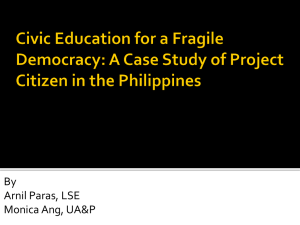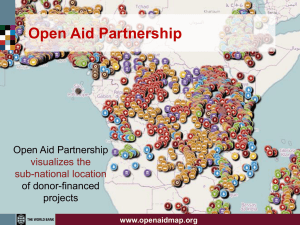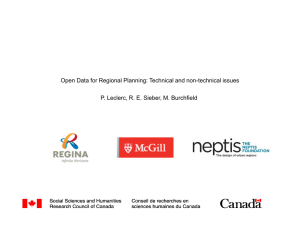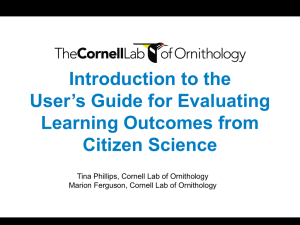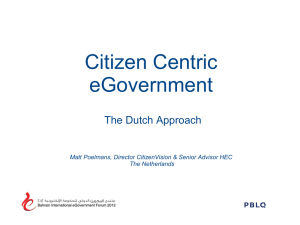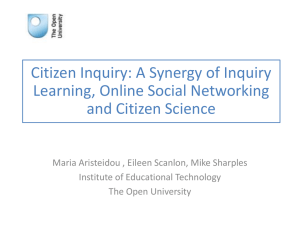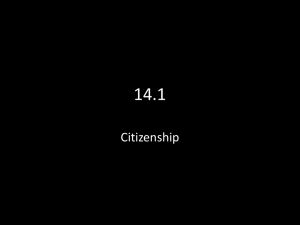Sevottam Workshop - Department of Administrative Reforms and
advertisement
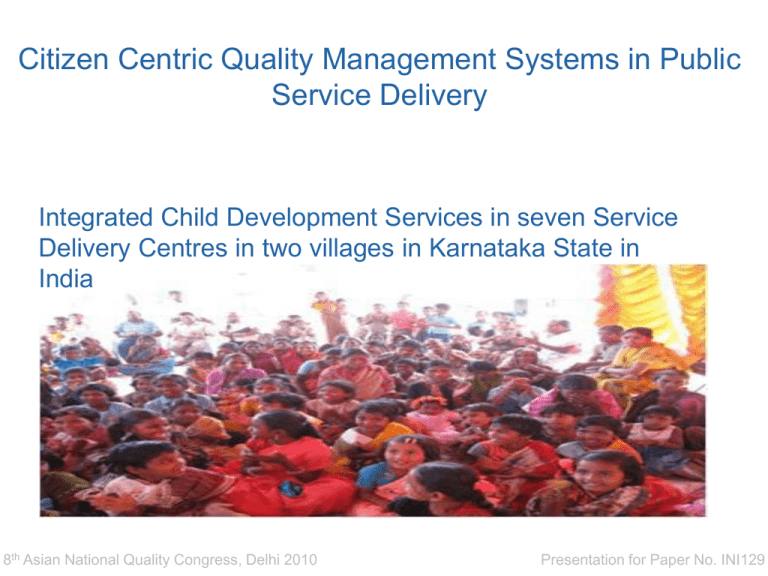
Citizen Centric Quality Management Systems in Public Service Delivery Integrated Child Development Services in seven Service Delivery Centres in two villages in Karnataka State in India 8th Asian National Quality Congress, Delhi 2010 Presentation for Paper No. INI129 The three Sections of this presentation Section 1 Section 2 Section 3 The Citizen Centric Quality Management System Framework Project Implementation structure Highlights of the Initiative Pro – Poor Service Delivery based on Quality for Reduction in poverty Social Sector Research shows a strong and positive correlation between equitable and efficient service delivery to the poor and overall reduction in poverty Equitable Service delivery Systems need to be:Based on Quality Standards that are well documented and well publicized PricewaterhouseCoopers Efficient in their delivery such that they can be measured both by the service providers and by the citizens Simple to Understand and Use BUT major Gaps exist between intent and outcome due to which Public Service Delivery Systems tend to fail the poor “How do we connect policy with operations?” politician “We sometimes assume that policies will implement themselves.” PricewaterhouseCoopers citizen Civil Servant “The civil service requires a better delivery culture.” Quality Management System called Sevottam framework aims at filling these gaps through a simple process The Quality Management System (QMS) developed by the Department of Administrative Reforms and Public Grievances, Government of India, is called SEVOTTAM The term is a combination of two Hindi words – ‘Uttam’ + ‘Seva’= Sevottam It is backed by an Indian Standard IS 15700 :2005 that was especially created for certifying achievement of excellence in service delivery in the government service sector Sevottam seeks excellence by focusing on Quality Standards based Public Service Delivery only Government’s services delivery should not be a game of dice Citizen’s should know what to expect ? how much to expect? from whom ? when ? And where? Uncertainty is sought to be removed through published standards The QMS Sevottam framework provides the answer through three modules that help to identify Gaps in Service Delivery 1. Citizen’s Charter – that specifies and publishes the standards of service delivery 2. The Grievance Redress Mechanism that process complaints from citizens when standards in Citizen’s Charter are not met in the service delivery 3. Capacity Building for service delivery to bring improvements on a continuous basis 2 Common Understanding 1. 3. Promised Delivery Expectations Desired Delivery Common Understanding 4. Actual Delivery Perceived Delivery 8th Asian National Quality Congress, Delhi 2010 Presentation for Paper No. INI129 Identified Gaps are filled through the QMS Sevottam framework for which the following logo is used for awareness The Three Modules of QMS Sevottam Framework PricewaterhouseCoopers Simple Seven Steps that cover the entire QMS Sevottam framework PricewaterhouseCoopers ‘Sevottam’ – Assessment/Improvement Model: Quality Criteria and Benefits Critical Areas(3) Integrated Model for Assessing Service Delivery Citizen Charter Criteria(9) Elements for assessment* (33) Implementation 5 Monitoring 3 Review 3 BENEFITS Healthy competition to achieve excellence Citizen empowerment Redress Satisfaction Public Grievance Redress Service Delivery Capability Receipt 3 Redress 3 Prevention 5 Customers 5 Employees 3 Infrastructure 3 Delivery Capability enhancement Compliance with basic standards * As questions which are rated on a five point scale ranging from “ad hoc” to “Systematic” Project Implementation Structure and Stakeholders DWCD DARPG ATI PwC DARPG, GoI • Project Sponsor • Keen on improvement of public service quality across various departments / states DWCD, GoK (Client) • Client state/ end-user department • Piloting Sevottam/ QMS for improving service delivery Administrative Training Institute (ATI) • State capacity building agency • Absorb QMS support capacity • To assist future Sevottam roll-outs to other departments in the state PricewaterhouseCoopers • Implementation agency/ consultant • Provide expertise and responsible to implement the project in pilot locations Promoting Excellence in Service Delivery 8th Asian National Quality Congress, Delhi 2010 Presentation for Paper No. INI129 ICDS in pilot districts • Chamrajnagar Project − Chamrajnagar District − Tribal Project: 529 sanctioned AWCs − Eligible 25,230 children; 3,237 PW & 3,023 LM − Pilot in Badanaguppe Village (4 AWCs) • Manvi Project − Raichur District − Rural Project: 381 sanctioned AWCs − Eligible: 46,558 children; 4436 PW & 5017 LM − Pilot in Mudlapura Village (3 AWCs) • Both projects sanctioned in 1990-91 Promoting Excellence in Service Delivery Project Methodology ASSESS PHASE (Dec 08 to Mar 09) DESIGN PHASE (Apr-09 to Aug-09) CONSTRUCT PHASE (Sep 09 to Oct 09) IMPLEMENT PHASE (Nov 09 to Mar 10) 8th Asian National Quality Congress, Delhi 2010 1 Initial interactions with project officials and study of existing processes in the pilot locations 2 Stakeholder interactions on key issues in ICDS and QMS rollout; Framing sectoral standards 3 Preparation of draft QMS manual & implementation plan; Sevottam training for officials 4 Sevottam implementation in pilot location, documentation & preparation of QMS manual Presentation for Paper No. INI129 Project Stages: Key Activities & Project Documents Stage II: DESIGN Stage I: ASSESS KEY ACTIVITY Project Initiation meeting Initial field visit to both pilot locations by PwC Project Initiation meeting Detailed AS-IS study in pilot locations KEY ACTIVITY Stakeholder consultations at pilot locations –set sector standards, identify targets and KPIs Document 1: Inception Report: project brief, a summary of the ICDS scheme and Sevottam model, approach and methodology Document 2: AS-IS Analysis report: Project details and benchmarking; Detailed functional assessment of 15 key business processes of ICDS with process maps; Roles and views of all key stakeholders Document 3: Discussion note on Sector Standards in ICDS in Karnataka: Lists sector standards, targets and KPIs identified based on citizen and stakeholder consultations Internal Stakeholder consultations Document 4: Note on Key issues in implementing QMS: Citizen State level stake holder Workshop Satisfaction Survey; Identification of current status and key issues in Citizen consultation and Surveys implementing in 5 areas of Sevottam; 8th Asian National Quality Congress, Delhi 2010 Presentation for Paper No. INI129 Stage IV: IMPLEMENT Stage III: CONSTRUCT Project Stages: Key Activities & Project Documents KEY ACTIVITY Draft Initial Action Items Note Prioritization of implementation activities Preparation of the QMS Framework Concept Note: Public Grievance Redress Concept Note: Better Monitoring with MIS Infrastructure assessment tool KEY ACTIVITIES Implementation activities in pilot locations Documentation commenced across dept Final Citizen satisfaction survey Document 5: Quality Management System and Implementation Methodology for Pilot: contains citizen’s inputs regarding sector standards compared with current provisions; draft service quality manual having detailed design of QMS framework. implementation methodology and activities for pilot implementation Document 6: Note on insight in to implementation process for full service delivery chain Document 7: Users’ Manual for implementing QMS Creation of institutional structures to take Sevottam implementation forward Preparation of Citizen Charter Document lessons learnt from Sevottam and prepare users manual 8th Asian National Quality Congress, Delhi 2010 Presentation for Paper No. INI129 Capacity Building and Involvement of State Administrative Training Institute, Mysore • Three day training and certification course on “Implementation of Service Quality in Public Service Organizations as per IS 15700: 2005 given to around 17 officials of department and 3 faculty from ATI • Sevottam Workshop at district level for field level functionaries • Presentation on Sevottam to all personnel concerned in the State • Capacity built through full time involvement of a faculty team of two coordinator from the State Administrative Training Institution, Mysore • Funds released by DARPG to create Sevottam Training Cell to institutionalize and disseminate service quality to DWCD and other departments in the State Government Citizen’s Satisfaction Survey and the four groups of initiatives All the 89 households eligible for availing the ICDS benefits in the 7 Anganwadi Centres in the two villages were surveyed at the beginning in September 2009 and again at the end of the pilot project in March 2010 The results from the surveys were utilized for creation of service standards for the Citizen’s Charter Initiatives are clustered in to four Groups:Group 1. Citizen’s Charter and Grievance Redress Mechanism - creation and activation as a tool to empower service recipients Group 2. Pre-School Education Group 3. Supplementary Nutrition Packages Group 4 Infrastructure and others Citizen Satisfaction Survey and 10 Categories of its Results •Categories in the survey results: 1.Awareness about Integrated Child Development Services (ICDS) 2.Integrated Child Development Services availed 3.Access to ICDS services 4.Citizen Satisfaction for each ICDS service 5.Rating for each service and overall rating 6.Satisfaction with AWW/ AWH/ BVS 7.Feedback on Complaint Handling Process 8.Specific responses Supplementary Nutrition Package (SNP) 9.Awareness and Satisfaction about Pilot Initiatives (only in final survey) 10.Suggestions for improvements/ changes Group 1. Citizen’s Charter and Grievance Redress Mechanism – creation and activation S No Initiatives 1 Drafting of Citizen Charter containing standards of service delivery under ICDS 2 Grievance Redress Mechanism created and activated Details Formulation of Citizen Charter STAKEHOLDERS CONSULTED MODE Beneficiaries – Mothers of Children, Pregnant and Lactating Women Citizen Survey on Sector Standards, Focus Group Discussions, Questionnaires Local Community -Bal Vikas Samiti members, Sector Help Group members, Gram Panchayat members, Focus Group Discussions, Structured Questionnaires Experts, Academicians and Researchers, NGO’s, Sector experts Workshops, Structured Questionnaires, Interviews Health Department staff– ANMs, LHV’s, BHEO, Medical Officers, THO Focus Group Discussions, Structured Questionnaires, Interviews DWCD Department staff– AWHs, AWW’s, Supervisors, ACDPOs, CDPOs, DPOs, Head office staff Focus Group Discussions, Structured Questionnaires, Interviews, Meetings Working group for Citizens Charter Meetings Citizen charter prepared in both English and Kannada and available in both print and online versions Summary chart is to be put up across all 65,000 Anganwadi Centres in state Group 2 - Pre-school Education S No Initiatives 3 Annual Bal Mela Function 4 New PSE Kits Details Pre-school Education - continued- S No Initiatives Details 5 Uniform and Footwear for all PSE children •Identified from Citizens Survey •Chamarajnagar – GP provided funds •Raichur – Funds raised from Community Mobilization 6 Support group of elderly ladies and kishoris (unmarried women) to assist AWW • Initiated to increase community participation and quality •Core Groups formed in all pilot AWCs and sessions running at least once a week 7 Child Progress Card implemented – to be repeated annually •Checklist of child development milestones for Socioemotional development, Language cognitive skills, Motor skills etc. •CPC was done for all children attending the preschool activity and results shared with parents Citizen Survey - Sector Standards - Pre School Education PSE starting Age PSE starting Time 1 year 30% 8 AM 1% 2 years 29% 9 AM 57% 3 years 41% 9:30 AM 36% PSE completion Age 3 years 38% 4 years 1% 5 years 3% 6 years 57% Topics – “Kannada & English - numbers and alphabets”; “cultural activities”; “sports”; “discipline”; “story telling”; “current topics and activities are satisfactory” 10 AM 6% PSE completion Time 12 PM 4% 1 PM 47% 1:30 PM 9% 2 PM 29% 3 PM 3% 4 PM 7% Suggestions – “Improvement in quality”; “More AWW training”; “Sports equipment and event among children”; “Extra-curricular and cultural activities”; “Emphasis on writing and learning”; “Minimum PUC pass requirement for AWW”; “Children shown practical things around village” Pre- School Education - Community Participation/ Monitoring S No Initiatives 8 Mobilization of funds through community and other schemes (BRGF, NRHM) 9 Monthly Monitoring by BVS members 10 Grading of AWCs by using UNICEF methodology Details UNICEF has developed a methodology for grading of AWC by CDPO/ Supervisor Grading of AWC was carried out in the pilot locations with results of grading being displayed in the AWC. Group 3 Supplementary Nutrition S No Initiatives 11 Akshaya Patra (Inexhaustible Vessel / Pot) 12 Assessment to foresee impact of new WHO growth norms Details Supplementary Nutrition – continued S No Initiatives 13 Hemoglobin test to establish level of malnutrition Details Group 4 - Infrastructure and others S No Initiatives 14 Infrastructure and Facilities assessment tool developed 15 Provision of LPG cylinders and Water filters in all AWCs 16 Re-introduction of Health Referral Slips and ICDS clinic Day Details Conducted in pilot locations Has been scaled up across the state Satisfaction with Project Initiatives from Citizen Survey Citizen Satisfaction Survey - Sample results SNP – Cooked Food Baseline Final Pre-School Education Baseline Final Citizen Satisfaction Survey – Pre-School Education Baseline Very Poor Poor Fair Good Very Good Final Very Poor Poor Fair Good Very Good Citizen Satisfaction Survey –Supplementary Nutrition Packages Baseline Very Poor Poor Fair Good Very Good Final Very Poor Poor Fair Good Very Good Citizens’ responses on sector standards in ICDS Citizen Survey - Sector Standards - Pre School Education Yes (unprompted) Yes (from list) Yes (Combined) Uniform 50% 43% 93% Toys & playthings 49% 43% 92% Books for children 43% 45% 88% Footwear 38% 53% 91% Slate and chalk pieces 32% 62% 94% Children to be taught 3Rs 19% 73% 92% Playground at AWC 12% 65% 77% Blackboard for children at AWC 11% 57% 68% Transfer Certificate (TC) 7% 77% 84% Mats for children to sit on 7% 62% 69% Benches for children to sit on 3% 32% 35% Report Card 1% 84% 85% Others – bags, scholarships, pens Thank You! Floor open for Discussions

